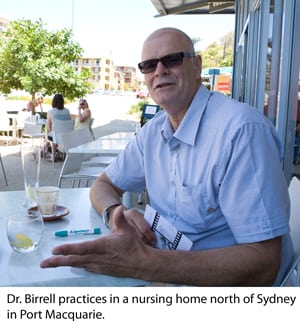
I recently spoke on geriatrics, humanistic medicine, and art at The International Arts and Health Conference in Port Macquarie, Australia. Because I spent so much of my medical career in long-term care, I sought out the opportunity to visit a nursing home to speak with staff and make comparisons on how we do things in the States. I also had lunch with one of the physicians whose practice is partially based in the facility. What I discovered sheds light on our different cultures and medical systems. Like America, Australia is an aging society with 20% of its population over 60 years old. The government has been proactive in developing an infrastructure with a major priority of keeping elders at home for as long as possible. There is an extensive government funded education and support service sponsored by Alzheimer’s Australia, the national body which manages the program.
There is an Australian equivalent to assisted living for persons requiring some personal assistance and supervision, but the term is “hostel” services. It seems identical to ours, just with a different name – much as Aussies call an elevator a “lift,” and a pharmacy a “chemist.” Nursing homes come under the heading of “residential services,” and there are two levels: normal and high care. “High care” is equivalent to America’s skilled care, and includes specialized Alzheimer’s units. For entry into high care, there is a multidisciplinary Age Care Assessment Team (ACAT), mandated and set up by the Australian government. The ACAT is essentially the gatekeeper for the high care population.
I spent some time with Joy Walsh, Director of Nursing at Emmaus, a fifty bed facility with Catholic Care of the Aged. About four hours driving time north of Sydney, the facility is surrounded by rolling hills where kangaroos and koalas make their home. I toured the Emmaus facility with Joy Walsh, and found it to be modern with wide halls and doors, high ceilings, and open, airy corridors. Each resident had a sun-filled, private room with large windows and a lot of shelf storage. The building was immaculately clean, and I saw several staff scrubbing floors and safety railings. Some residents had wide, flat computer screens and were surfing the web! I learned about the large number of community volunteers who assist with pastoral care and activities for the residents.
When I questioned the Director of Nursing regarding operations, I found huge differences with how things are done in the States. For example, the facilities are not required to have an administrator or medical director – these functions are all done by the DON. There is no such thing as the Minimum Data Set (MDS), and physicians are required to see patients only once every three months. I found no equivalent to the vigorous “rehab” or subacute services that are part of the fabric of most American nursing homes.
Unlike America, which has been subject to stringent laws governing nursing homes since 1987, regulation of this industry is relatively new in Australia. Similar to America, the push to regulate evolved from consumer groups and the political power of an expanding population of elders. Beginning in 2000, there were new standards developed by the Aged Care and Accreditation Standards agency. This agency performs unannounced surveys which inspect system-based as well as clinical care outcomes. I was surprised and impressed with the sophistication of the regulatory emphasis on safe and effective systems. The standards also address issues such as independence, privacy and dignity, the right to vote, and “security of tenure” ensuring that the resident cannot be arbitrarily discharged.
 I had lunch with a physician who cares for patients in the facility, Dr. Mike Birrell. Dr. Birrell is a general practitioner with half his practice dedicated to nursing home residents. Australian doctors spend six years in medical school, followed by one year of general practice and two more years of post-graduate residency in a hospital. Dr. Birrell described his approach as purely holistic, fixing issues related to mobility and mentation, while maximizing both the quality and quantity of life for elders under his care.
I had lunch with a physician who cares for patients in the facility, Dr. Mike Birrell. Dr. Birrell is a general practitioner with half his practice dedicated to nursing home residents. Australian doctors spend six years in medical school, followed by one year of general practice and two more years of post-graduate residency in a hospital. Dr. Birrell described his approach as purely holistic, fixing issues related to mobility and mentation, while maximizing both the quality and quantity of life for elders under his care.
Australia has a remarkable govern- ment sponsored health insurance program which covers every citizen. I asked Dr. Birrell if he knew of anyone facing bankruptcy due to medical bills, and he told me that this scenario did not exist. There is also the option of private health insurance, which may allow quicker access to procedures and tests.
One striking difference between long-term care in America and Australia is the litigation situation. When I inquired whether nursing homes get sued for injurious falls or pressure ulcers, the Director of Nursing looked at me quizzically and remarked that these lawsuits were “unheard of.” I learned that Dr. Birrell’s malpractice insurance was a fraction of what a similar physician would pay in the States, and the concept of “defensive medicine” is virtually nonexistent. In Australia I got the impression that quality care is indeed possible without the threat of litigation, and that a better environment is created for caregivers without the additional worry.
* * * * * * * * * * * * * * *
To read more about my talk on Geriatrics, Humanistic Medicine and Art click here.

 I had lunch with a physician who cares for patients in the facility, Dr. Mike Birrell. Dr. Birrell is a general practitioner with half his practice dedicated to nursing home residents. Australian doctors spend six years in medical school, followed by one year of general practice and two more years of post-graduate residency in a hospital. Dr. Birrell described his approach as purely holistic, fixing issues related to mobility and mentation, while maximizing both the quality and quantity of life for elders under his care.
I had lunch with a physician who cares for patients in the facility, Dr. Mike Birrell. Dr. Birrell is a general practitioner with half his practice dedicated to nursing home residents. Australian doctors spend six years in medical school, followed by one year of general practice and two more years of post-graduate residency in a hospital. Dr. Birrell described his approach as purely holistic, fixing issues related to mobility and mentation, while maximizing both the quality and quantity of life for elders under his care. 